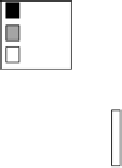Environmental Engineering Reference
In-Depth Information
350
Personal
300
Indoor
Outdoor
250
Activity
200
150
100
50
12.00
13.00
14.00
15.00
Time
16.00
17.00
18.00
FIGURE 6.5
Concentrations of personal, indoor, and outdoor PM
5
while people walked around a house.
(From Ferro, A.R. et al., Exposure to house dust from human activities,
Proceedings of Ninth International
Conference on Indoor Air Quality and Climate
, Monterey, CA, June 30-July 2, 2002, Vol. 1, pp. 527-532,
2002. With permission.)
6.2.2.4 Cleaning and Household Activities
Cleaning activities that involve only the movement of equipment and indoor furnishings, rather
than the use of cleaning chemicals, have been found to elevate personal exposure to particles. For
example, Ferro et al. (2002) reported that 15 min periods of bed making, folding clothes, and vacu-
uming increased (5 h average) PM
2.5
and PM
5
personal exposures to 1.4 and 1.6 times the indoor
concentrations for the same time periods, as shown in Figure 6.6. Textiles like sheets, towels, and
clothes shed ibers, but they can also collect and release airborne particles and indoor dust. Vacuum
cleaners without PM
2.5
ilters, as well as dry dusting and sweeping, re-disperse part of the settled
dust and indoor PM (Abt et al., 2000).
450
PM
2.5
PM
5
PM
10
400
350
300
250
200
150
100
50
0
FIGURE 6.6
Personal exposure to three size fractions of PM during indoor activities. BR = irst loor bed-
room; FF = irst loor; BM = basement; walk = continuous vigorous walking and sitting on furniture; vacuum
was a canister model with a paper iltration bag. (From Ferro, A.R. et al., Exposure to house dust from human
activities,
Proceedings of Ninth International Conference on Indoor Air Quality and Climate
, Monterey, CA,
June 30-July 2, 2002, Vol. 1, pp. 527-532, 2002. With permission.)





































































Search WWH ::

Custom Search